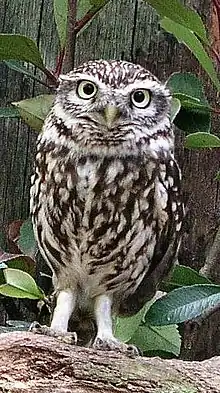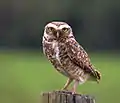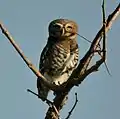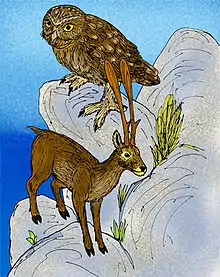Athene (bird)
Athene is a genus of owls, containing six living species, depending on classification. These birds are small, with brown and white speckles, yellow eyes, and white eyebrows. This genus is found on all continents except for Australia, Antarctica, and Subsaharan Africa.
| Athene Temporal range: Late Miocene to recent | |
|---|---|
 | |
| Little owl, Athene noctua | |
| Scientific classification | |
| Kingdom: | Animalia |
| Phylum: | Chordata |
| Class: | Aves |
| Order: | Strigiformes |
| Family: | Strigidae |
| Genus: | Athene F. Boie, 1822 |
| Type species | |
| Strix noctua Scopoli, 1769 | |
| Species | |
|
Athene blewitti | |
| Synonyms | |
|
Heteroglaux | |
Taxonomy and list of species
The genus Athene was introduced by the German zoologist Friedrich Boie in 1822.[1] The type species was designated as the little owl (Athene noctua) by the English zoologist George Robert Gray in 1841.[2][3] The genus name is from the little owl which was closely associated with the Greek goddess Athena, and often depicted with her. Her original role as a goddess of the night might explain the link to an owl.[4]
The genus contains the following five species.[5]
| Image | Scientific name | Common Name | Distribution |
|---|---|---|---|
.jpg.webp) | Athene noctua | Little owl | Europe, Asia east to Korea, and north Africa |
 | Athene brama | Spotted owlet | tropical Asia from mainland India to Southeast Asia |
 | Athene cunicularia - sometimes placed in Speotyto | Burrowing owl | North and South America |
%252C_Madagascar.jpg.webp) | Athene superciliaris | White-browed owl | Madagascar |
 | Athene blewitti - sometimes placed in Heteroglaux | Forest owlet | central India |
| Athene jacquinoti | Solomons boobook | Solomon Islands (archipelago) | |
Extinct species
A number of mainly island representatives of this genus are only known from fossil or subfossil remains:
- Athene megalopeza (fossil; Rexroad Late Pliocene of WC USA) - sometimes placed in Speotyto
- Athene veta (fossil; Early Pleistocene of Rebielice, Poland)
- Athene angelis (fossil; Middle - Late Pleistocene of Castiglione, Corsica)
- Athene trinacriae (Pleistocene)
- Athene cf. cunicularia (fossil; Pleistocene of Barbuda, West Indies) - sometimes placed in Speotyto
- Athene cf. cunicularia (fossil; Pleistocene of Cayman Islands, West Indies) - sometimes placed in Speotyto
- Athene cf. cunicularia (fossil; Pleistocene of Jamaica, West Indies) - sometimes placed in Speotyto
- Athene cf. cunicularia (fossil; Pleistocene of Mona Island, West Indies) - sometimes placed in Speotyto
- Athene cf. cunicularia (fossil; Pleistocene of Puerto Rico, West Indies) - sometimes placed in Speotyto
- Cretan owl, Athene cretensis (prehistoric; Crete, Mediterranean)
The Cretan owl was a flightless or near-flightless form that was more than 50 cm (almost 2 ft) tall. It went extinct soon after the island of Crete became inhabited by humans.
Late Miocene (about 11 mya) fossil remains from Rudabánya (NE Hungary) have been tentatively assigned to this genus.[6] Considering the known fossil range of Athene and the misassignments of many Miocene strigids from Europe, it may be a basal member of the present genus or not belong here. The supposed species "Athene" murivora is the name given to subfossil bones of male Rodrigues owls.
References
- Boie, Friedrich (1822). "Ueber Classification, insonderheit der europäischen Vogel". Isis von Oken (in German). Cols 545–564 [549].
- Gray, George Robert (1841). A List of the Genera of Birds : with their Synonyma and an Indication of the Typical Species of Each Genus (2nd ed.). London: R. and J.E. Taylor. p. 7.
- Peters, James Lee, ed. (1940). Check-List of Birds of the World. Volume 4. Cambridge, Massachusetts: Harvard University Press. p. 147.
- Jobling, James A (2010). The Helm Dictionary of Scientific Bird Names. London: Christopher Helm. pp. 58, 274. ISBN 978-1-4081-2501-4.
- Gill, Frank; Donsker, David; Rasmussen, Pamela, eds. (2020). "Owls". IOC World Bird List Version 10.2. International Ornithologists' Union. Retrieved 30 September 2020.
- Bernor, R.L.; Kordos, L. & Rook, L. (eds): "Recent Advances on Multidisciplinary Research at Rudabánya, Late Miocene (MN9), Hungary: A compendium. Archived 2007-06-28 at the Wayback Machine" Paleontographica Italiana 89: 3-36.
